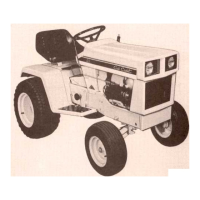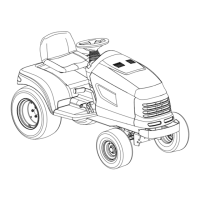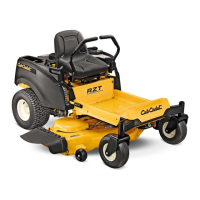ELECTRICAL SYSTEM
108
ELECTRICAL DIAGNOSIS
NOTE: Electrical diagnostic procedures and
tools are the same for all Cub Cadet and MTD
tractors. This section is written in a way to pro-
vide basic trouble shooting skills that can be
used on any tractor.
With a basic understanding of the behavior of electricity
and the tools used to measure that behavior, a techni-
cian can be about 80% effective at finding electrical
problems. 80% effective is not bad, but the remaining
20% of the diagnoses are the really difficult ones that
can devour the same amount of time as the easy
80%. Experience plays a big part in successfully diag-
nosing the really difficult electrical problems. Experi-
ence leads to greater understanding.
Two German Physicists, working independently during
the late 18th and early 19th centuries summarized
what they had figured-out about electricity into some
basic laws that can help a technician understand how a
system works or why it does not work. Their names
were Gustav Kirchhoff and Georg Ohm, and their laws
are named for them.
There are basically three things that a technician is
likely to test in trying to identify an electrical problem:
Volts, Resistance, and Current. To help technicians
understand the behavior of electricity, this section
begins with an explanation of:
• Basic electrical values.
•Ohm’s law.
• Kirchhoff’s current law.
• Kirchhoff’s voltage law.
• How the system is wired together.
NOTE: A graphic explanation of Kirchhoff’s laws
ca n be f o un d at t h e f o l lo w i ng w e b s i te :
http://online.cctt.org/physicslab/content/phyapb/
lessonnotes/DCcircuits/lessonKirchoff.asp
The section then continues by explaining handy tools
and techniques for diagnosing electrical problems on
outdoor power equipment.
Electronics
The outdoor power equipment has historically had rela-
tively simple electro-mechanical controls. Customer
expectations and regulatory demands continue to drive
change in the industry, while electronic controls have
become relatively inexpensive.
In many cases, electronic controls can simplify a sys-
tem that would otherwise be very complex. Instead of
creating a huge mass of switches and relays that are
tied together by spaghetti-like wiring harness, sensors
(switches) in an electronic system send signals to a
processor. These input signals are processed by a
control module that produces outputs.
Outputs can include power to run an electric PTO
clutch, a trigger signal to a starter solenoid, or the
grounding of a magneto to turn-off an engine if an
unsafe condition exists.
Most electronic devices are quite dependable, but they
are vulnerable to things that simple electrical devices
are not bothered by. Examples include:
• EMI: Electro-Magnetic Interference is created by
electronic “noise”. This noise is created by igni-
tion systems in general with non-resistor spark
plugs being especially “noisy”. Alternators, and
even power passing through wires can also gen-
erate EMI. Countermeasures against EMI
include metal shielding (take a look at the igni-
tion system on a fiberglass-bodied Corvette),
and filtering devices built into vulnerable compo-
nents. Something as simple as putting non-
resistor spark plugs in a machine with electronic
controls can disable the controls.
• Voltage Spikes: A dramatic increase in voltage
will damage many electronic devices. Such
spikes may be caused when jumper cables are
disconnected or a voltage regulator fails. Some
early automotive systems could even be dam-
aged by personal discharge of static electricity.
Most are better protected now.
• Low Voltage: Many electronic devices simply
stop working if system voltage falls below a
given threshold. If a 12 volt system is run at 11
volts with a failing alternator, electronic controls
may stop working.
• Bad Grounds: Bad grounds can reduce the
effective system voltage, create resistance and
heat, and send false signals. This is the single
most common breeding ground of electronic
gremlins.
